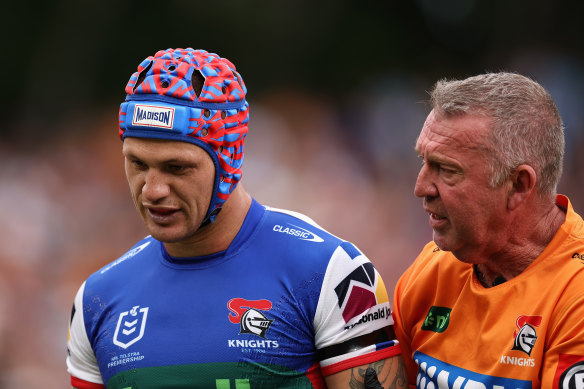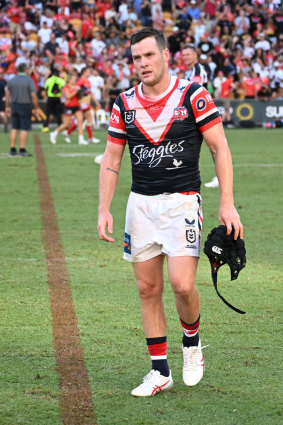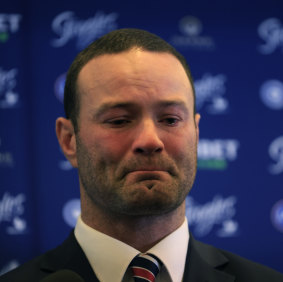NRL set to introduce 11-day stand-down for concussion – but Ponga needs longer
If you needed an indication of the complexities of concussion and what rugby league should do about it, you only had to witness what happened at Leichhardt Oval on Sunday afternoon.
In the second minute, Knights captain Kalyn Ponga clashed heads while trying to make a tackle and went reeling backwards. It was a sickening blow, not least because of his history with head knocks: it was his fourth in 10 months.
As he left the field, the Tigers faithful gave him the same, sombre clap fans give players who have been stretchered from the field after a serious injury. It was a classy act, but their visceral response spoke to fears that Ponga might be concussed out of the game.
When the Knights held on for a 14-12 win, and the players embraced each other, Ponga sprinted from the sidelines and jumped on the huddle. He’d been sitting on the bench for most of the second half, making observations to the coaching staff and teammates.
They reckon the human heart is a mystery – but what about the brain?
This week, the ARL Commission will decide if a mandatory 11-day stand-down for players suffering concussions should be implemented.
Kalyn Ponga leaves the field against the Tigers.Credit:Getty
It’s another attempt to apply black-and-white protocols to the greyest of areas. Some will say it’s too inflexible, while others – particularly from rival codes – will say it should have been introduced sooner.
Let’s cut the NRL some slack. It’s juggling issues of player welfare and the looming threat of litigation while trying to preserve a game built on collision and brutal impact.
There is so much misinformation about concussion protocols that people are sounding off about things they don’t know about.
Coaches blasted the interference of the independent doctor last week – including Ponga and his coach, Adam O’Brien. Fans jumped on the bandwagon, claiming they were unfairly ruling players out of matches from the Bunker.
For those in the cheap seats one more time, the independent doctor does not rule out players. They identify concussion symptoms the club doctor or trainers may not have seen in the run of play and order a Head Injury Assessment.
Sure, the system isn’t without fault. On Friday night, Parramatta captain Clint Gutherson was sent for an HIA after Cronulla centre Jesse Ramien clobbered him with a brutal – but legal – tackle.
The tackle wasn’t high and Gutherson showed no signs of being hurt, let alone concussed, and eventually returned to the field.
Perhaps a better protocol would be for the independent doctor to communicate with the club doctor, and then an assessment can be made on whether the player should leave the field. Again, it’s not an exact science.
Asked after the Tigers win about Ponga being sidelined for a lengthy period, O’Brien said it was too early to tell. “We’ll just follow the protocols,” he said.
Which is fair enough. You trust Newcastle to do the right thing by their player – by all their players – and this will be no different.
But maybe the Knights should take the lead of the Roosters, who have wrestled with concussion more than any other club, having watched former captains Boyd Cordner and Jake Friend retire in the past two years.
Luke Keary has suffered plenty of concussions.
When Bulldogs boss Phil Gould blasted the introduction of the independent doctor as the “greatest abomination in the history of the game” last week, Roosters five-eighth Luke Keary was the voice of reason, saying players needed to be saved from themselves.
Having suffered a series of head knocks, Keary is better placed than most to comment.
Ponga’s growing catalogue of concussions is different to those of Cordner, who towards the end of his career displayed symptoms from the slightest of head knocks.
Nevertheless, O’Brien might take the lead of Roosters coach Trent Robinson, who elevated his duty of care above the NRL’s rules, when working out how to treat his captain.
After Cordner was concussed while playing for NSW in an Origin match in November 2020, the Roosters put him through a raft of testing with the best neurological specialists in the country. Scans revealed he had a “pristine” brain.
“There was nothing to suggest he shouldn’t play football again,” Robinson told me at the time. “If you do all the tests, and nobody says he should retire, and you believe in the capability of the body to heal, in the elasticity of the brain to heal itself, you start on a plan to get him back to training. All the testing came back positive. If it came back negative, it would’ve been a different story.
Boyd Cordner’s retirement press conference was emotional for all involved.Credit:Getty Images
“But it wasn’t a matter of just taking a couple of months off before getting back into it. The option to start the season was not an option. It wasn’t even discussed. If you tear a hamstring, lay on the lounge and then run again, you’ll do your hamstring.”
Despite all the testing and his gradual return to training, Cordner eventually realised it was time to walk away. He never played another game and retired. His media conference was so emotional, the hack reporters huddled around him had tears in their eyes.
Ponga is 24. He has a long career ahead of him. There would be no shame in him taking off the rest of the year and there should be no pressure on his return.
The NRL is loath to hand out salary cap dispensation to clubs, but it’s something the ARL Commission must consider for players ruled out for long periods. Ponga is on the Knights’ cap for $1.4 million a year. There should be incentives for clubs and players to err on the side of caution.
For every former player who slams concussion as a myth – Gould compared it to “climate change” conspiracies – I could name another five who are showing debilitating signs from a life playing rugby league.
Keary is right: players do need to be saved from themselves and the game must help them.
Stream the NRL Premiership 2023 live and free on 9Now.
Sports news, results and expert commentary. Sign up for our Sport newsletter.
Most Viewed in Sport
From our partners
Source: Read Full Article



